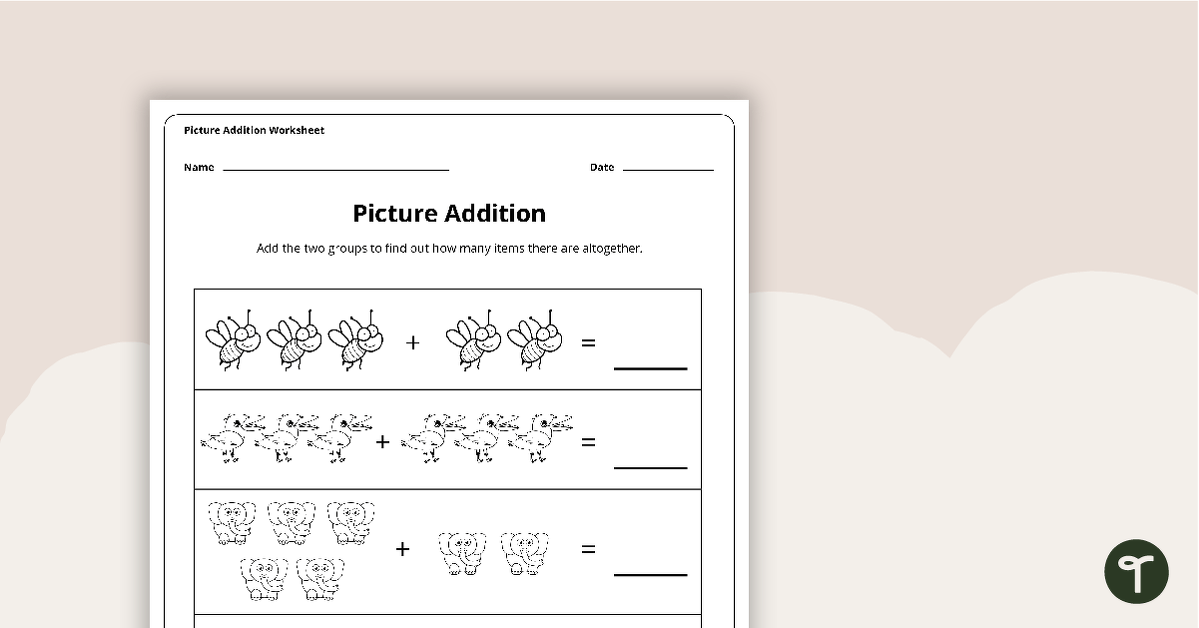A worksheet consolidating students' understanding of combining groups of items.
Students are required to add the items together and write the total on the sheet.
Updated: 01 Jun 2020
A worksheet consolidating students' understanding of combining groups of items.
Non-Editable: PDF
Pages: 1 Page
Years: F - 2
Represent practical situations, including simple financial situations, involving addition, subtraction and quantification with physical and virtual materials and use counting or subitising strategies <ul> <li>using role-play and materials to represent mathematical relationships in stories; for example, role-playing ‘Eight kangaroos were drinking at the river and 3 hopped away’, drawing a picture and using materials to represent the situation, discussing, and recording the result of the action with a numeral</li> <li>role-playing or actively engaging in situations that involve quantifying or comparing collections of items or simple money transactions; for example, engaging with the question ‘Do we have enough scissors for our group so that each person has their own pair?’, or role-playing using $1 coins to pay for items in a shop where items are priced in whole dollars</li> <li>representing situations expressed in Aboriginal and/or Torres Strait Islander stories, such as ‘Tiddalick, the greedy frog’, that describe additive situations and their connections to Country/Place</li> <li>representing addition and subtraction situations found in leaf games involving sets of objects used to tell stories, such as games from the Warlpiri Peoples of Yuendumu in the Northern Territory</li> </ul>
Represent practical situations that involve equal sharing and grouping with physical and virtual materials and use counting or subitising strategies <ul> <li>using materials to role-play equal sharing; for example, sharing pieces of fruit or a bunch of grapes between 4 people and discussing how you would know they have been shared equally; or, when playing card games where each player is dealt the same number of cards, counting the number of cards after the deal to ensure they have the same amount</li> <li>representing situations that involve counting several items; for example, starting with 9 beads or 6 $1 coins and then sharing them equally between 3 people by subitising or counting each group by ones to decide how many beads or coins each person will receive</li> <li>exploring instructive games of Aboriginal and/or Torres Strait Islander Peoples that involve sharing; for example, playing Yangamini of the Tiwi Peoples of Bathurst Island to investigate and discuss equal sharing</li> </ul>
Reads numerals and represents whole numbers to at least 20
Reasons about number relations to model addition and subtraction by combining and separating, and comparing collections
Represents the relations between the parts that form the whole, with numbers up to 10
Forms equal groups by sharing and counting collections of objects
Represent practical situations to model addition and sharing
Represent and solve simple addition and subtraction problems using a range of strategies including counting on, partitioning and rearranging parts
Represent practical situations involving addition, subtraction and quantification with physical and virtual materials and use counting or subitising strategies
Represent practical situations involving equal sharing and grouping with physical and virtual materials and use counting or subitising strategies
Add and subtract numbers within 20, using physical and virtual materials, part-part-whole knowledge to 10 and a variety of calculation strategies

A worksheet consolidating students' understanding of combining groups of items.
Students are required to add the items together and write the total on the sheet.
Represent practical situations, including simple financial situations, involving addition, subtraction and quantification with physical and virtual materials and use counting or subitising strategies <ul> <li>using role-play and materials to represent mathematical relationships in stories; for example, role-playing ‘Eight kangaroos were drinking at the river and 3 hopped away’, drawing a picture and using materials to represent the situation, discussing, and recording the result of the action with a numeral</li> <li>role-playing or actively engaging in situations that involve quantifying or comparing collections of items or simple money transactions; for example, engaging with the question ‘Do we have enough scissors for our group so that each person has their own pair?’, or role-playing using $1 coins to pay for items in a shop where items are priced in whole dollars</li> <li>representing situations expressed in Aboriginal and/or Torres Strait Islander stories, such as ‘Tiddalick, the greedy frog’, that describe additive situations and their connections to Country/Place</li> <li>representing addition and subtraction situations found in leaf games involving sets of objects used to tell stories, such as games from the Warlpiri Peoples of Yuendumu in the Northern Territory</li> </ul>
Represent practical situations that involve equal sharing and grouping with physical and virtual materials and use counting or subitising strategies <ul> <li>using materials to role-play equal sharing; for example, sharing pieces of fruit or a bunch of grapes between 4 people and discussing how you would know they have been shared equally; or, when playing card games where each player is dealt the same number of cards, counting the number of cards after the deal to ensure they have the same amount</li> <li>representing situations that involve counting several items; for example, starting with 9 beads or 6 $1 coins and then sharing them equally between 3 people by subitising or counting each group by ones to decide how many beads or coins each person will receive</li> <li>exploring instructive games of Aboriginal and/or Torres Strait Islander Peoples that involve sharing; for example, playing Yangamini of the Tiwi Peoples of Bathurst Island to investigate and discuss equal sharing</li> </ul>
Reads numerals and represents whole numbers to at least 20
Reasons about number relations to model addition and subtraction by combining and separating, and comparing collections
Represents the relations between the parts that form the whole, with numbers up to 10
Forms equal groups by sharing and counting collections of objects
Represent practical situations to model addition and sharing
Represent and solve simple addition and subtraction problems using a range of strategies including counting on, partitioning and rearranging parts
Represent practical situations involving addition, subtraction and quantification with physical and virtual materials and use counting or subitising strategies
Represent practical situations involving equal sharing and grouping with physical and virtual materials and use counting or subitising strategies
Add and subtract numbers within 20, using physical and virtual materials, part-part-whole knowledge to 10 and a variety of calculation strategies

We create premium quality, downloadable teaching resources for primary/elementary school teachers that make classrooms buzz!
Would you like something changed or customised on this resource? While our team makes every effort to complete change suggestions, we can't guarantee that every change will be completed.
Did you spot an error on this resource? Please let us know and we will fix it shortly.
Are you having trouble downloading or viewing this resource? Please try the following steps:
If you are still having difficulty, please visit the Teach Starter Help Desk or contact us .

One hundred and one addition flashcards with numbers 0-10.

A fun game for students to play in small groups to consolidate their understanding of adding and subtracting in groups of 10, 100 and 1000.

One hundred and one addition flashcards with numbers 0-10.

One hundred and one addition flashcards with numbers 0-10.

One hundred and one addition flashcards with numbers 0-10.

A fun and simple adding activity to consolidate simple addition.

A fun, interactive maths game for students to play when doubling numbers from 1 to 12.

A fun game for students to play when doubling two digit numbers.

Ninety addition 10 to 100 two-digit plus one-digit addition flashcards.

A fun game using addition, subtraction, multiplication and division.
0 Comments
Write a review to help other teachers and parents like yourself. If you'd like to request a change to this resource, or report an error, select the corresponding tab above.